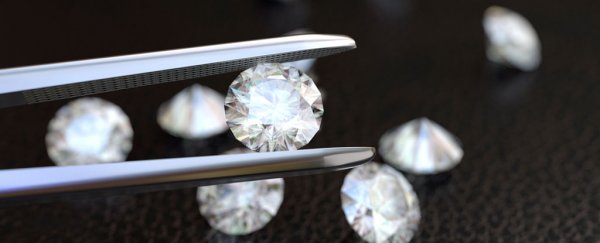Scientists have figured out how to use nuclear waste as an energy source, converting radioactive gas into artificial diamonds that could be used as batteries.
These diamonds, which are able to generate their own electrical current, could potentially provide a power source for thousands of years, due to the longstanding half-life of the radioactive substances they're made from.
"There are no moving parts involved, no emissions generated, and no maintenance required, just direct electricity generation," says geochemist Tom Scott from the University of Bristol in the UK.
"By encapsulating radioactive material inside diamonds, we turn a long-term problem of nuclear waste into a nuclear-powered battery and a long-term supply of clean energy."
Scott's team has so far demonstrated a prototype diamond battery that uses an unstable isotope of nickel (nickel–63) as its radiation source.
Nickel 63 has a half-life of approximately 100 years, meaning the researchers' prototype device would still hold about 50 percent of its 'charge' in 100 years' time.
But the scientists say there's an even better source they could work with – and doing so would end up providing a solution for the UK's massive stockpiles of nuclear waste.
The first generation of Magnox nuclear reactors in the UK produced during the 1950s through to the 1970s used graphite blocks to help sustain the nuclear reactions, but the technique comes at a cost.
During the process, the graphite blocks themselves become radioactive, generating an unstable carbon isotope, carbon–14.
The last of these Magnox reactors was retired in 2015, but after decades of nuclear power generation, there's an awful lot of waste byproduct left over, with almost 95,000 tonnes of these graphite blocks needing to be safely stored and monitored while they remain radioactive.
And that could be a pretty long time, given that carbon–14 has a half-life of about 5,730 years.
While that means carbon–14 has to be stored for an extremely long time, it also means the material could make for some amazingly long-lasting batteries – if it can be repurposed into the diamond structure, like the team did with nickel–63.
"Carbon–14 was chosen as a source material because it emits a short-range radiation, which is quickly absorbed by any solid material," says one of the researchers, Neil Fox.
"This would make it dangerous to ingest or touch with your naked skin, but safely held within diamond, no short-range radiation can escape. In fact, diamond is the hardest substance known to man, there is literally nothing we could use that could offer more protection."
The team shared details of their work at an "Ideas to change the world" lecture at the University of Bristol last week, but haven't published their research as yet, so we'll have to wait and see to find out how viable their carbon–14 batteries really could be.
According to the researchers, carbon–14 batteries would only be good for low-power applications – but their endurance would be on a whole different scale.
"An alkaline AA battery weighs about 20 grams, has an energy density storage rating of 700 Joules/gram, and [uses] up this energy if operated continuously for about 24 hours," Scott told Luke Dormehl at Digital Trends.
"A diamond beta-battery containing 1 gram of C14 will deliver 15 Joules per day, and will continue to produce this level of output for 5,730 years — so its total energy storage rating is 2.7 TeraJ."
That level of output could make the diamond batteries useful "in situations where it is not feasible to charge or replace conventional batteries", Scott said in a press release.
"Obvious applications would be in low-power electrical devices where long life of the energy source is needed, such as pacemakers, satellites, high-altitude drones or even spacecraft."
It's early days yet, but what's exciting about this research is that it could provide a useful purpose for a huge amount of radioactive waste, in addition to giving us such amazing battery life.
"This is a great example of where the UK could literally make value from waste," Scott told Digital Trends.
You can find out more on the research in the video below:

